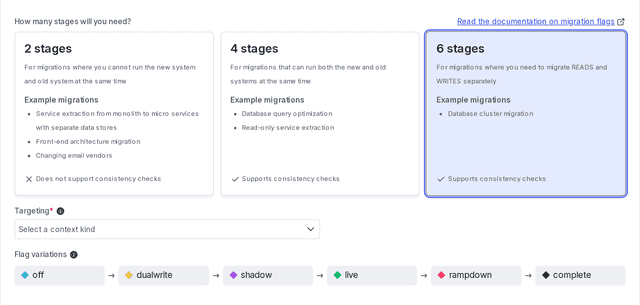Migration flags
Read time: 2 minutes
Last edited: Oct 21, 2024
Overview
This topic explains how you can use migration flags to take the complexity and risk out of migrations when you need to change or modernize your database infrastructure. Migration flags require a server-side SDK.
Supported SDKs
Migration flags are available for the following server-side SDKs:
Migration flags are also available for the following edge SDKs:
About migration feature flags
A migration feature flag is a temporary flag you can use to migrate data or systems while keeping your application available and disruption free. Migration flags break the transition from an old to a new implementation into a series of two to six stages. Movement between stages occurs in discrete steps. Migration flags also let you split traffic across two or more cohorts. Cohorts can also move between stages independently from each other and in incremental steps.
Migration flags help you understand more about how your migrations progress, their health, and how to mitigate risks if unintended behavior occurs.

To learn more about when to use different types of migrations, read Performing multi-stage migrations with migration flags.
How migration flags affect migration stages
A migration flag's variations are associated with the migration's stages. To learn more, read Targeting variations and stages.

About cohorts
Migration flag cohorts are analogous to a standard feature flag's rules. The default cohort is analogous to a feature flag's default rule. Cohorts always serve a rollout release type. To learn more, read Targeting cohorts and Percentage rollouts.